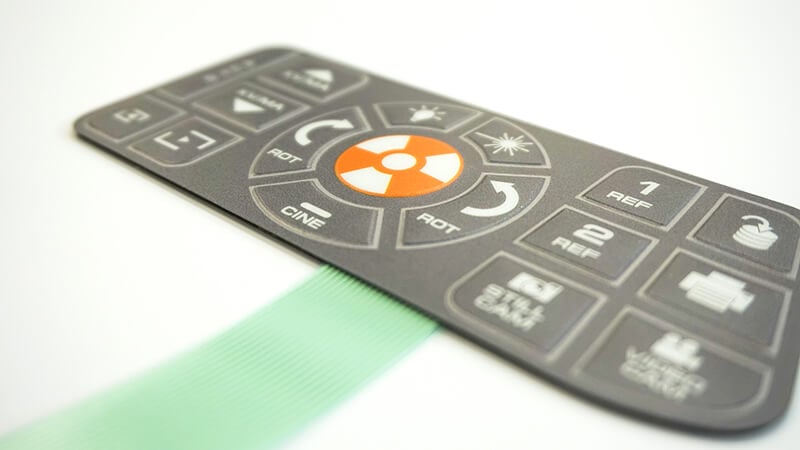The Full Guide to Membrane Switch Innovation and Its Applications
The Full Guide to Membrane Switch Innovation and Its Applications
Blog Article
Recognizing the Capability of Membrane Layer Switches Over for Interface Devices
The functionality of membrane layer switches stands for a substantial development in user interface design, combining effectiveness with aesthetic versatility. As industries increasingly prioritize user experience, recognizing the subtleties of membrane button technology comes to be essential.
What Are Membrane Buttons?
Membrane switches are cutting-edge user interface tools that promote user communication with digital devices. These versatile parts contain multiple layers, including a graphic overlay, spacer, and a printed circuit layer. The layout enables a seamless integration into numerous digital gadgets, enhancing both the visual and useful facets of user interfaces.
Membrane layer buttons are frequently employed in a wide variety of applications, from home home appliances to industrial machinery and medical gadgets. Their construction generally features a slim account, making them an excellent option for compact designs. The tactile feedback provided by these buttons can be engineered to satisfy particular individual choices, guaranteeing reliable interaction in between the customer and the gadget.
Toughness is an additional considerable advantage of membrane layer switches, as they are immune to dust, wetness, and chemicals, which enhances their lifespan sought after settings. Furthermore, these buttons can be personalized in regards to shape, size, and graphic style, permitting branding and user-specific features. On the whole, membrane changes represent a practical remedy for boosting user experience in digital tools, incorporating functionality with aesthetic charm in an efficient way.
Exactly How Membrane Layer Changes Job
Operating on a simple principle, membrane switches over use a layered building and construction to register individual input properly. Each button is composed of multiple layers, consisting of a printed circuit layer, a spacer layer, and a top graphic layer, which are developed to collaborate perfectly. When a customer presses the top layer, it compresses the spacer layer, bringing the conductive components of the circuit layer into contact with each other.
This call develops a closed circuit, signifying the device to execute a specific function. The style enables different setups, consisting of responsive feedback, which can enhance the customer experience by supplying a physical experience upon activation. The materials used in membrane switches often consist of adaptable substrates, such as polyester or polycarbonate, which ensure toughness and strength versus wear and tear.

Secret Benefits of Membrane Layer Buttons

An additional substantial advantage is their compactness. Membrane buttons are thin and lightweight, which allows makers to save space in their devices without sacrificing capability. This attribute is particularly useful in applications where weight and volume are important factors to consider.
In addition, membrane buttons are immune to dust, dampness, and chemicals, boosting their sturdiness. This durability extends their lifespan and decreases the demand for constant replacements, causing cost financial savings over time.
Moreover, the tactile comments supplied by membrane buttons can be maximized to enhance user communication. They can include functions such as increased switches or audible clicks, enhancing use and individual experience.
Applications Throughout Industries
User interface tools making use of membrane buttons are prevalent in a vast variety of industries, showcasing their adaptability and performance. Membrane Switch. In the clinical sector, membrane switches are indispensable to gadgets such as analysis tools and person monitoring systems, where their toughness and ease of cleaning are important for preserving health standards. In a similar way, in the auto industry, these switches are used in control panel controls and infomercial systems, giving a sleek and contemporary user interface for individuals.
Moreover, the consumer electronic devices sector gain from membrane layer buttons in appliances and portable gadgets, where small design and user-friendly user interfaces boost user experience. Industrial applications likewise take advantage of membrane switches for control board in equipment and automation systems, highlighting their robustness and resistance to rough environments.
In the aerospace and defense industries, membrane layer buttons are used in cabin controls and equipment, where reliability and directory performance under extreme conditions are vital. Additionally, the pc gaming sector increasingly integrates membrane layer buttons in controllers and game makers, adding to an Discover More Here interesting customer experience. Overall, the adaptability of membrane changes enables their extensive use across countless sectors, emphasizing their importance in modern-day individual interface layout.
Future Patterns in Membrane Layer Switch Over Innovation

Additionally, making use of advanced products, such as polycarbonate and polyester films, is expected to rise, providing enhanced resilience and resistance to ecological stressors. These materials add to the general longevity of membrane layer switches, making them suitable for harsher commercial applications.
Additionally, the consolidation of smart technology, consisting of IoT connectivity, will certainly allow membrane buttons to communicate with other tools and systems, facilitating a more interactive individual experience. This trend straightens with the expanding demand for wise tools throughout various fields, from healthcare to consumer electronic devices.
Last but not least, modification alternatives are prepared for to increase, enabling makers to create bespoke services customized to certain individual needs and choices. These developments will certainly position membrane buttons as necessary parts in the evolution of interface modern technology.
Final Thought
In conclusion, membrane layer switches over represent a critical innovation in user interface innovation, using a trustworthy and functional remedy for look at these guys diverse electronic applications. As advancements in material scientific research and touch noticing modern technologies proceed, the performance and applicability of membrane layer buttons are anticipated to expand, enhancing their importance in modern electronic devices.
Report this page